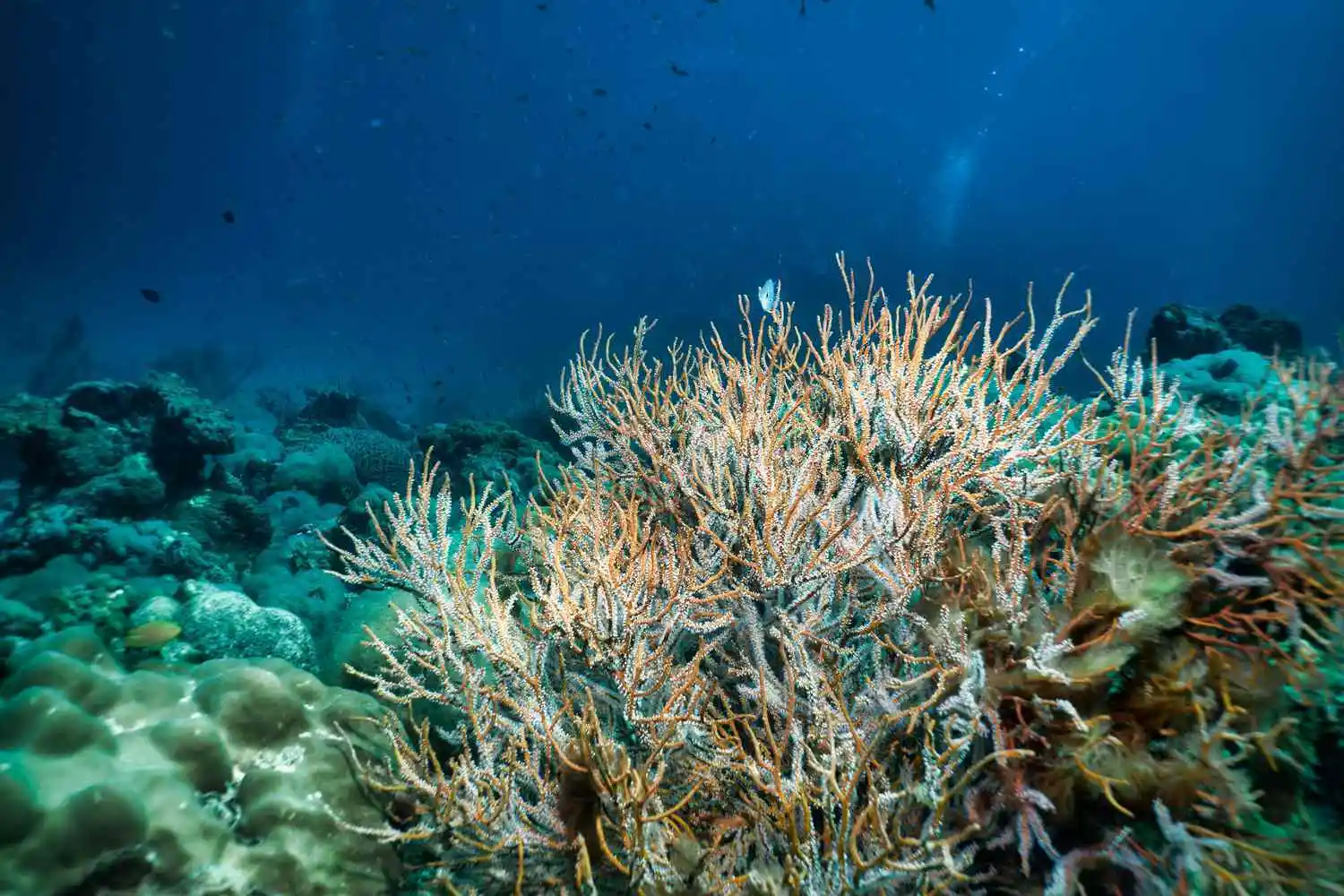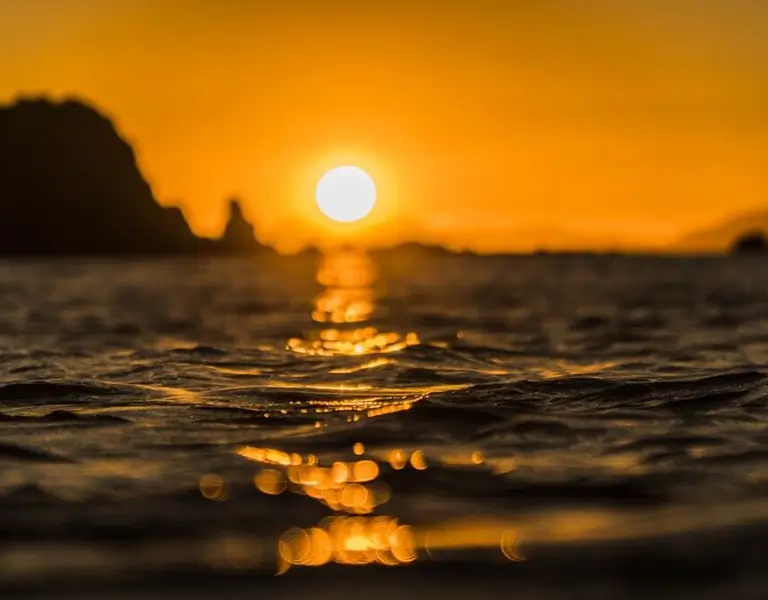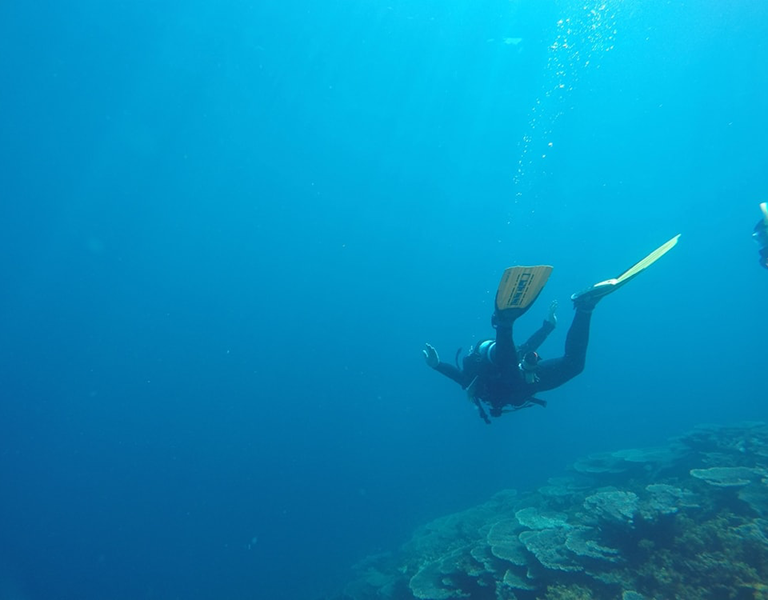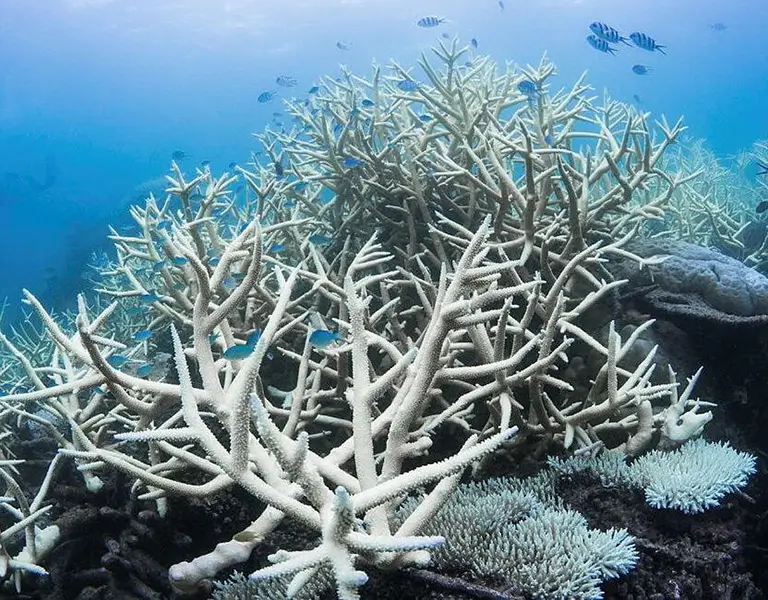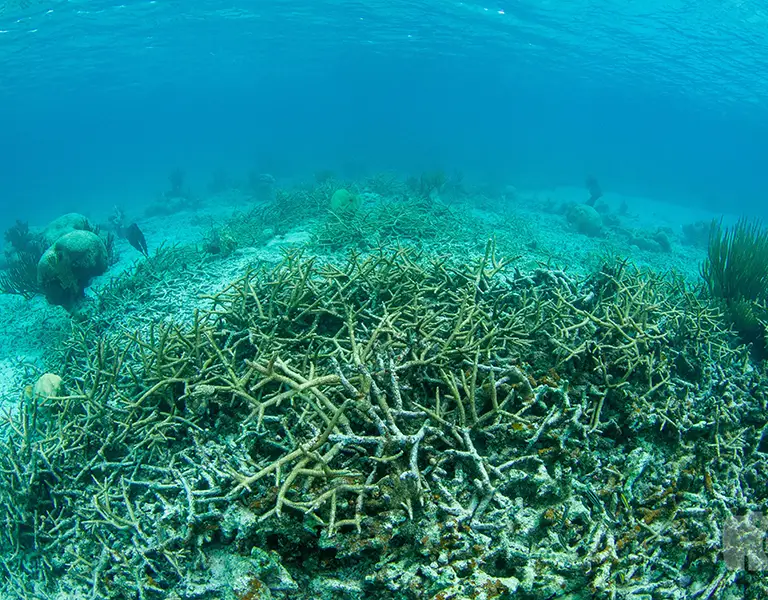Key Takeaways
- Ocean acidification occurs when the seas absorb about 30% of human carbon emissions, causing a 30% increase in acidity since the Industrial Revolution
- Marine life that builds shells and skeletons – including corals, shellfish, and plankton – face imminent threats as acidifying waters dissolve calcium carbonate structures
- Coral reefs form distinct structural formations including fringing reefs (along coastlines), barrier reefs (separated from shore by lagoons), atolls (circular formations), and patch reefs (isolated structures), each adapted to specific environmental conditions.
- Regional variations show some areas acidifying up to 10 times faster than global averages, particularly in polar and coastal regions
- Solutions require immediate carbon emission reductions combined with local protection strategies like marine protected areas and coral restoration
What is Ocean Acidification?
The seas are turning sour. Every day, our oceans absorb roughly 22 million tons of carbon dioxide – about one-quarter of all human CO2 emissions [1]1. What begins as invisible gas becomes a chemical cascade that fundamentally rewrites the story of ocean chemistry.
When atmospheric carbon dioxide seeps into ocean water, it undergoes what scientists call “oceanic invasion.” The CO2 doesn’t just dissolve; it transforms, creating carbonic acid that splits into hydrogen ions and bicarbonate. This seemingly simple chemistry creates ripples through entire ecosystems. Since the Industrial Revolution, our seas have absorbed enough carbon to fill the planet’s atmosphere 44 times over [2]2.
The numbers tell a stark story: ocean pH has dropped from 8.2 to 8.1 – a seemingly modest shift that actually represents a 30% increase in acidity. If we continue on our current trajectory, surface waters could plummet to pH 7.8 by 2100, creating conditions not seen in 55 million years [3]3.
Ocean Chemistry Under Siege
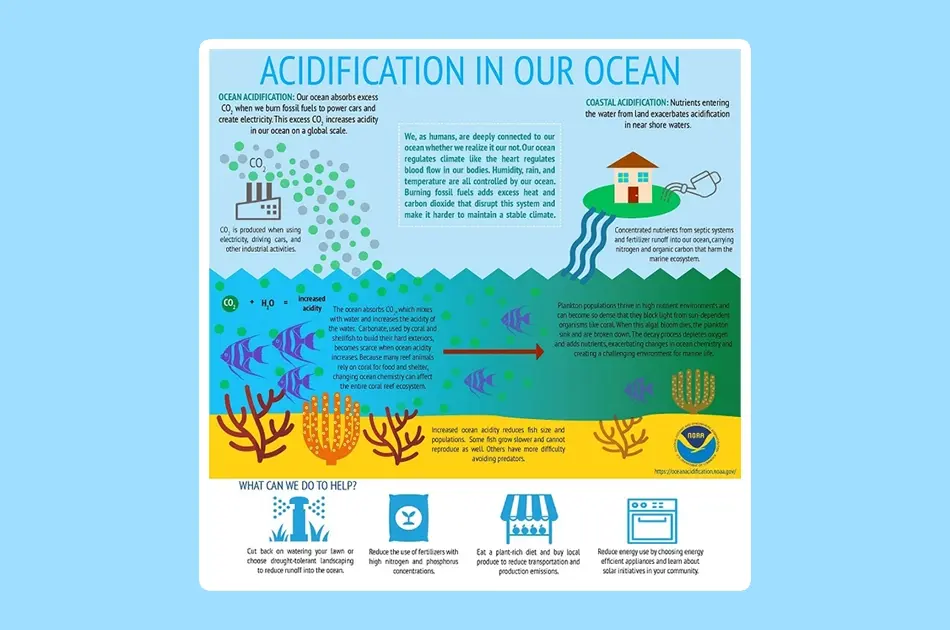
The seas maintain a delicate chemical equilibrium that has endured for millennia. Seawater naturally buffers between pH 7.5 and 8.4, creating alkaline conditions where life thrives. This stability allowed marine ecosystems to flourish, with creatures evolved for specific conditions spanning mere hundredths of a pH unit.
But our carbon deluge overwhelms this ancient balance. The ocean’s carbonate buffering system, once unshakeable, now buckles under pressure. As atmospheric CO2 soars from pre-industrial levels of 280 ppm to today’s 415 ppm, the chemical guardrails that protected marine life for eons are crumbling [4]4.
Different ocean regions respond uniquely to this invasion. Surface waters, in direct contact with the atmosphere, acidify fastest. The North Atlantic Ocean demonstrates some of the most dramatic changes, while the Pacific shows surprising heterogeneity driven by currents and circulation patterns. Each region’s chemistry tells its own story of transformation and stress.
Carbon Dioxide: The Invisible Invader
Carbon dioxide doesn’t announce its arrival in ocean waters. It simply seeps in, molecule by molecule, transforming from atmospheric villain to oceanic enemy. About 25% of annual CO2 emissions find their way into our seas, where they trigger a chain reaction of chemical changes [5]5.
The mechanism is deceptively simple yet devastatingly effective. CO2 combines with water to form carbonic acid, which immediately breaks down into hydrogen ions – the very measure of acidity – and bicarbonate. This process consumes carbonate ions that marine life desperately needs to build shells and skeletons.
As the surface ocean becomes more saturated with CO2, its ability to absorb more diminishes. Scientists estimate that by century’s end, the ocean could lose up to 30% of its current carbon-absorbing capacity, creating a feedback loop that accelerates both climate change and acidification [6]6.
Coral Reefs: Canaries in the Chemical Mine
7Coral reefs face a double assault from climate change. While rising temperatures trigger devastating bleaching events, acidification silently undermines the very structure that holds these ecosystems together. Corals require specific pH levels to precipitate calcium carbonate, the mineral foundation of their skeletons [7].
As carbonate ions become scarcer, corals must work harder to build their homes. This increased energy expenditure leaves less for growth, reproduction, and surviving stress. Some branching corals show up to 30% reduced growth rates under projected acidification scenarios [8]8.
Deep-sea corals face even grimmer prospects. Without sunlight, these creatures rely entirely on water chemistry for calcification. Recent studies show communities shifting from hard coral dominance to soft coral and algal turf as acidification progresses – a transformation that reshapes entire ecosystems.
The Calcification Crisis
The creatures that build our oceans – the calcifying organisms – now find themselves in a chemical war they never evolved to fight. From microscopic coccolithophores to giant clams, from tiny snails called pteropods to spiny sea urchins, the fundamental building blocks of marine life struggle to maintain their structures.
Sea urchins demonstrate this crisis vividly. Their purple spines, once formidable defenses, become weakened and brittle in acidified water. Oregon’s coastal waters have already witnessed massive sea star die-offs linked to pH changes, cascading through kelp forest ecosystems [9]9.
Shellfish aquaculture faces immediate threats. West Coast oyster hatcheries experienced 80% larvae mortality during acidification events, costing millions in lost production. These aren’t distant future scenarios – they’re present-day wake-up calls demanding immediate action [10]10.
Food Webs in Freefall
Ocean acidification doesn’t just affect individual species; it unravels the intricate tapestry of marine food webs. Pteropods, delicate sea butterflies that drift through our oceans, serve as crucial prey for salmon, herring, and cod. As their calcium carbonate shells dissolve, the repercussions cascade upward through the food chain [11]11.
The foundation of ocean life – phytoplankton and zooplankton – shows mixed responses to changing chemistry. Some species thrive with additional CO2 for photosynthesis, while others falter. This reshuffling of oceanic building blocks could fundamentally alter which species dominate future seas.
Fish don’t use calcium carbonate, but they don’t escape acidification’s reach. Research suggests altered pH affects their sensory systems, potentially impairing their ability to detect predators, locate prey, and find suitable habitats. The cumulative effects ripple through entire marine ecosystems [12]12.
Marine Resources: A Trillion-Dollar Question
The numbers are staggering: global marine resources generate over $3 trillion annually, supporting 350 million jobs worldwide [13]13. Ocean acidification threatens this blue economy at its foundation, from wild fisheries to maricultural operations.
Sustainable development of marine resources requires radical rethinking. Industries already adapting include West Coast oyster farms investing in monitoring systems and pH buffering technologies. But these are stopgap measures against a rising tide that demands systemic solutions.
The cost of inaction dwarfs investment in adaptation. Coral reef ecosystems alone provide $375 billion annually in services – from coastal protection to fisheries support to tourism revenue. As acidification threatens these functions, the economic imperative for action becomes crystal clear [14]14.
The Climate Change Convergence
Two crises spring from the same source: excess carbon in our atmosphere. Ocean acidification and global warming represent twin threats born of burning fossil fuels, creating compound stressors that marine life never evolved to face simultaneously.
Global ocean temperatures have risen 0.6°C since 1900, with the most rapid warming occurring in recent decades [15]15. The interaction creates perfect storms – coral bleaching events coinciding with carbonate availability crashes, mass mortality events where multiple stressors overwhelm resilience.
This convergence demands integrated solutions. Addressing just one threat while ignoring the other leaves marine ecosystems vulnerable to the remaining assault. We must think in systems, act comprehensively, and respond with the urgency these parallel crises demand.
Regional Acidification Patterns
Not all oceans acidify equally. Arctic waters acidify fastest – cold water absorbs CO2 more readily, while melting ice reduces buffering capacity. Some regions show acidification rates 10 times the global average, creating acidification hotspots that demand immediate attention [16]16.
Coastal areas experience particularly complex patterns. Upwelling brings naturally acidic deep water to the surface, compounding atmospheric CO2 effects. River discharge can both buffer and worsen acidity, depending on geology and pollution. Understanding these regional variations is crucial for targeted conservation efforts.
The Great Barrier Reef, West Antarctic Ice Sheet, and California Current system all show unique acidification signatures. Each region requires tailored strategies based on local chemistry, biology, and human impacts [17]17.
Monitoring Our Changing Seas
Scientists track acidification through innovative monitoring networks spanning the globe. Moored buoys collect real-time data, autonomous gliders patrol ocean sections, and dedicated research vessels map chemical changes across vast areas. The Global Ocean Acidification Observing Network (GOA-ON) coordinates these efforts, creating an unprecedented view of ocean chemistry transformation [18]18.
The measurements reveal troubling trends: current acidification rates exceed natural variations by orders of magnitude. What took thousands of years in Earth’s past now happens in decades, challenging species’ adaptive capabilities and ecosystem resilience.
Advanced sensors can detect pH changes smaller than 0.001 units – critical precision for understanding how minor shifts create major ecological disruptions. This monitoring forms the foundation for both understanding impacts and evaluating solutions.
Natural Acidification Lessons
While human activities drive current acidification, natural processes offer glimpses into future scenarios. Volcanic CO2 seeps create localized acidification zones where marine communities transform dramatically. Biodiversity plummets, but some species flourish, providing insights into future ecological structures [19]19.
The Paleocene-Eocene Thermal Maximum (PETM), occurring 56 million years ago, saw ocean acidification accompany massive carbon release. However, that event unfolded over thousands of years, allowing species time to adapt or migrate – a luxury unavailable to modern marine life facing change in decades [20]20.
These natural experiments inform our understanding while emphasizing current acidification’s unprecedented rate and scope.
Human Fingerprints on Ocean Chemistry
The primary driver is unmistakable: burning fossil fuels pumps roughly 40 billion tons of CO2 annually into the atmosphere [21]21. Industrial processes, deforestation, and cement production add to this carbon burden, with 30% ultimately dissolved in our seas.
Agricultural runoff and coastal development create additional pressures. Nutrient pollution triggers algal blooms that, upon dying, consume oxygen and release more CO2. These localized effects compound global acidification, creating regional acidification hotspots [22]22.
Land-use changes further impact our carbon cycle. Draining wetlands and clearing forests not only release stored carbon but also reduce natural carbon sinks, leaving more CO2 available for ocean absorption. The human fingerprint on ocean chemistry grows more distinct with each passing year.
Pathways to Ocean Recovery
Solutions require action at multiple scales. Global carbon reduction through renewable energy transition forms the foundation – addressing acidification’s root cause while mitigating climate change impacts. The Paris Agreement targets offer hope but demand more ambitious implementation [23].23
Localized strategies complement global efforts. Marine protected areas reduce additional stressors, helping ecosystems build resilience. Some regions experiment with seagrass restoration, which naturally buffers water chemistry while providing habitat and carbon sequestration benefits.
Emerging technologies offer additional tools. Ocean alkalinity enhancement shows promise for increasing buffering capacity, though careful study ensures no unintended consequences. Carbon capture and storage could reduce atmospheric CO2, though scalability remains a critical challenge [24]24.
Protected Areas as Refuges
Marine protected areas offer islands of resilience in acidifying seas. By eliminating fishing pressure, pollution, and physical damage, MPAs allow ecosystems to allocate more energy toward acidification adaptation. Studies show protected areas maintain greater biodiversity and stronger ecosystem functioning under stress [25]25.
Strategic placement of MPAs considers ocean chemistry. Areas with natural buffering through geology or circulation patterns could serve as refugia where sensitive species persist. These protected zones might act as stepping stones, helping species migrate as acidification progresses.
Research within MPAs provides real-world laboratories for studying acidification impacts and adaptation strategies under different management scenarios.
Future Under Acid
Climate models paint sobering pictures of future oceans. Under high emission scenarios, surface pH could drop to 7.7-7.8 by 2100, representing chemical conditions unprecedented in millions of years [26]26. Even moderate scenarios show substantial acidification by mid-century.
Economic modeling suggests acidification could cost the global economy hundreds of billions annually by 2100, affecting industries from seafood to tourism [27]27. However, early action dramatically reduces these costs while preserving marine ecosystems’ intrinsic value.
Real-World Impact Stories
The Pacific Northwest’s struggle offers a stark preview. Hatcheries faced 80% oyster larvae mortality as natural acidification combined with atmospheric CO2 absorption. Industry adaptation includes million-dollar investments in monitoring systems and pH buffering – costs that smaller operations cannot bear [28]28.
Wild fisheries face similar challenges. Alaska’s sockeye salmon depend on pteropods that dissolve in acidifying water. Commercial fishing communities watch their traditional grounds become less productive, forcing difficult decisions about future livelihoods [29]29.
These stories connect chemistry to communities, making acidification’s abstract threat tangibly real through human impact.
Science Advancing Understanding
Research reveals surprising adaptations in marine life. Some mussel populations show remarkable pH tolerance, while others remain vulnerable. Understanding these differences could inform restoration strategies and species selection for future coral reefs [30]30.
Genomic studies uncover mechanisms behind acidification tolerance, potentially enabling selective breeding programs for aquaculture. However, the question remains whether evolutionary adaptation can match projected acidification rates.
Innovative research methods, including bioenergetic modeling and proteomics, offer deeper insights into organism-level responses to acidification, improving our ability to predict and manage ecosystem changes.
Adaptation Frontiers
Marine organisms demonstrate varying abilities to cope with changing chemistry. Some species show remarkable plasticity within generations, while others require longer evolutionary timescales. Understanding these differences helps prioritize conservation efforts [31]31.
Natural CO2 seeps provide glimpses into future communities. While some species thrive, overall biodiversity typically decreases, suggesting significant restructuring of marine ecosystems. These windows into the future guide management decisions.
Aquaculture industries increasingly focus on selective breeding for acidification tolerance, recognizing that survival may require assisted adaptation for valuable species and ecosystem engineers.
The Weakening Carbon Sink
Our oceans currently absorb about 25% of annual CO2 emissions, buffering the atmosphere from even worse carbon accumulation [32]32. However, this absorption capacity decreases as waters warm and acidify, potentially creating a carbon feedback loop.
Understanding these changing dynamics is crucial for climate modeling. Some research suggests the ocean might absorb 30% less CO2 by century’s end, accelerating atmospheric carbon buildup and compounding both acidification and warming [33]33.
The relationship between acidification, ocean circulation, and carbon absorption involves complex feedback mechanisms that climate models must capture for accurate future projections.
Climate Solutions for Ocean Health
Addressing ocean acidification demands comprehensive climate action. Transitioning to renewable energy doesn’t just stabilize atmospheric CO2 – it prevents further ocean acidification while mitigating warming’s compound effects.
Nature-based solutions offer additional benefits. Protecting and restoring coastal ecosystems like mangroves and seagrass beds sequesters carbon while providing natural buffering against acidification for adjacent waters [34]34.
Blue carbon initiatives recognize oceans as both victim and potential solution to climate crisis, integrating marine conservation with carbon mitigation strategies.
Policy Frameworks
International agreements increasingly recognize ocean acidification’s threat. The UN Convention on the Law of the Sea (UNCLOS) and Convention on Biological Diversity (CBD) provide frameworks for addressing acidification through marine conservation [35]35.
National policies vary widely. Some countries implement dedicated acidification monitoring programs, while others address it only through broader climate legislation. This disparity highlights needs for enhanced international cooperation.
The Ocean Acidification International Coordination Centre facilitates knowledge sharing, recognizing that this global challenge demands unified response across borders.
Hope in Action
Despite immense challenges, success stories inspire continued effort. Pacific oyster farms have adapted rapidly, implementing innovative monitoring and management systems. These industry responses demonstrate humanity’s capacity for adaptation [36]36.
Marine protected areas show increased resilience, proving that local actions provide meaningful protection even against global threats. Research continues uncovering adaptation mechanisms that could inform conservation strategies.
Technological advances in renewable energy and carbon capture offer pathways for addressing acidification’s root cause while supporting economic development. Combined with ecosystem protection and restoration, these approaches provide our best hope for ocean recovery.
United for Ocean Protection
Ocean acidification represents humanity’s greatest chemical experiment with the sea. Its nearly invisible nature belies profound impacts on marine life and human communities. Understanding this crisis is our first step toward solutions.
The path forward demands coordinated action: dramatic carbon emission reductions to address acidification’s cause, strategic marine protection to build ecosystem resilience, innovative restoration techniques to repair damaged habitats, and supportive policies that bridge science and management.
We cannot afford to wait for perfect solutions. Every action that reduces carbon emissions, protects marine habitats, or educates communities contributes to ocean health. The choices we make today determine whether future generations inherit seas teeming with life or waters too acidic to sustain the biodiversity that enriches our blue planet.
Time flows like the tide – it waits for no one. But unlike the tide, if we fail to act now, ocean acidification may not ebb back to healthier waters within any foreseeable future. Our oceans need champions, and that responsibility falls on all of us.
About Coral Vita
Coral Vita is a mission-driven company dedicated to restoring our world’s dying and damaged reefs. Using innovative land-based farming techniques, Coral Vita grows diverse and resilient corals in months instead of the decades they take in nature. These corals are then transplanted into threatened reefs, helping to preserve ocean biodiversity while protecting coastal communities that depend on healthy reefs for protection, food, and income].[37]37.
Founded by environmental entrepreneurs Sam Teicher and Gator Halpern, Coral Vita’s high-tech coral farms incorporate breakthrough methods to restore reefs in the most effective way possible. In 2021, the company was recognized as the inaugural winner of Prince’s William’s Revive Our Oceans Earthshot Prize Winner for their pioneering work in coral restoration. [38]38.
To learn more about Coral Vita’s work or to get involved in coral reef conservation efforts, visit their website at www.coralvita.co or contact them directly through their Contact Us page.
References
- Friedlingstein, P., et al. (2022). Global Carbon Project (GCP) Global Carbon Budget 2022.
↩︎ - Doney, S.C., et al. (2009). Ocean acidification: The other CO2 problem. Annual Review of Marine Science. ↩︎
- Caldeira, K., & Wickett, M.E. (2003). Oceanography: Anthropogenic carbon and ocean pH. Nature. ↩︎
- IPCC (2021). Climate Change 2021: The Physical Science Basis. ↩︎
- Gruber, N., et al. (2019). The oceanic sink for anthropogenic CO2 from 1994 to 2007. Science. ↩︎
- Bolin, B., & Doos, B.R. (1989). The Greenhouse Effect, Climate Change and Ecosystems. John Wiley & Sons. ↩︎
- Hoegh-Guldberg, O., et al. (2007). Coral reefs under rapid climate change and ocean acidification. Science. ↩︎
- Comeau, S., et al. (2014). Ocean acidification affects the response of coral calcification to nitrogen limitation. Global Change Biology. ↩︎
- Bednaršek, N., et al. (2019). Systematic review and meta-analysis towards synthesis of thresholds of ocean acidification impacts on calcifying pteropods and interactions with warming. Frontiers in Marine Science. ↩︎
- Barton, A., et al. (2012). The Pacific oyster, Crassostrea gigas, shows negative correlation to naturally elevated carbon dioxide levels. Limnology and Oceanography. ↩︎
- Manno, C., et al. (2017). Shelled pteropods in peril: Assessing vulnerability in a high CO2 ocean. Earth-Science Reviews. ↩︎
- Sundin, J., et al. (2018). Ocean acidification affects neuroendocrine function in a declining marine fish population. Fish and Shellfish Immunology. ↩︎
- OECD (2016). The Ocean Economy in 2030. OECD Publishing. ↩︎
- Spalding, M., et al. (2017). Mapping the global value and distribution of coral reef tourism. Marine Policy. ↩︎
- Cheng, L., et al. (2021). Improved quantification of the rate of ocean warming. Journal of Climate. ↩︎
- Orr, J.C., et al. (2005). Anthropogenic ocean acidification over the twenty-first century and its impact on calcifying organisms. Nature. ↩︎
- Gattuso, J.P., et al. (2015). Contrasting futures for ocean and society from different anthropogenic CO2 emissions scenarios. Science. ↩︎
- Newton, J.A., et al. (2015). Global Ocean Acidification Observing Network: Requirements and Governance Plan. ↩︎
- Hall-Spencer, J.M., et al. (2008). Volcanic carbon dioxide vents show ecosystem effects of ocean acidification. Nature. ↩︎
- Zachos, J.C., et al. (2008). An early Cenozoic perspective on greenhouse warming and carbon-cycle dynamics. Nature. ↩︎
- Le Quéré, C., et al. (2022). Global Carbon Budget 2022. Earth System Science Data. ↩︎
- Feely, R.A., et al. (2019). Chemical and biological effects of ocean acidification along the West Coast of North America. Oceanography. ↩︎
- UNFCCC (2015). Paris Agreement. ↩︎
- Rau, G.H., et al. (2020). Negative carbon emissions via ocean alkalinity enhancement. Wiley Interdisciplinary Reviews: Climate Change. ↩︎
- Bates, A.E., et al. (2014). Resilience and signatures of tropicalization in protected reef fish communities. Nature Climate Change. ↩︎
- Bopp, L., et al. (2013). Multiple stressors of ocean ecosystems in the 21st century: Projections with CMIP5 models. Biogeosciences. ↩︎
- Mathis, J.T., et al. (2015). Economics of ocean acidification and coral reef restoration. Nature Climate Change. ↩︎
- Ekstrom, J.A., et al. (2015). Vulnerability and adaptation of US shellfisheries to ocean acidification. Nature Climate Change. ↩︎
- Mathis, J.T., et al. (2015). Ocean acidification risk assessment for Alaska’s fishery sector. Progress in Oceanography. ↩︎
- Kelly, M.W., et al. (2013). Adaptation to climate change: Trade-offs among responses to multiple stressors in an intertidal crustacean. Evolutionary Applications. ↩︎
- Kelly, M.W., & Hofmann, G.E. (2012). Adaptation and the physiology of ocean acidification. Functional Ecology. ↩︎
- Gruber, N., et al. (2019). The oceanic sink for anthropogenic CO2 from 1994 to 2007. Science. ↩︎
- Tjiputra, J.F., et al. (2019). Carbon release from subtropical North Atlantic Ocean surface waters under 21st century climate change. Journal of Geophysical Research. ↩︎
- Mcleod, E., et al. (2021). Taking a novel ecosystem-based approach to carbon sequestration and climate-resilient development. Ocean & Coastal Management. ↩︎
- United Nations (1982). United Nations Convention on the Law of the Sea (UNCLOS). ↩︎
- Waldbusser, G.G., et al. (2015). Ocean acidification has multiple modes of action on bivalve larvae. PLoS One. ↩︎
- Coral Vita (2023). Our Mission. www.coralvita.co/mission ↩︎
- The Earthshot Prize (2021). Winners & Finalists 2021. earthshotprize.org/winners-finalists ↩︎
